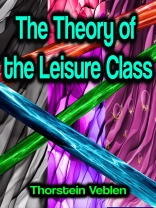The Theory of the Leisure Class Thorstein Veblen — The Theory of the Leisure Class: An Economic Study of Institutions (1899), by Thorstein Veblen, is a treatise on economics and a detailed, social critique of conspicuous consumption, as a function of social class and of consumerism, derived from the social stratification of people and the division of labour, which are social institutions of the feudal period (9th15th c.) that have continued to the modern era.Veblen asserts that the contemporary lords of the manor, the businessmen who own the means of production, have employed themselves in the economically unproductive practices of conspicuous consumption and conspicuous leisure, which are useless activities that contribute neither to the economy nor to the material production of the useful goods and services required for the functioning of society, while it is the middle class and the working class who are usefully employed in the industrialised, productive occupations that support the whole of society.
Об авторе
Thorstein (born ‘Torsten’) Bunde Veblen was a Norwegian-American economist and sociologist. He was famous as a witty critic of capitalism.Veblen is famous for the idea of ‘conspicuous consumption’. Conspicuous consumption, along with ‘conspicuous leisure’, is performed to demonstrate wealth or mark social status. Veblen explains the concept in his best-known book, The Theory of the Leisure Class (1899). Within the history of economic thought, Veblen is considered the leader of the institutional economics movement. Veblen’s distinction between ‘institutions’ and ‘technology’ is still called the Veblenian dichotomy by contemporary economists.As a leading intellectual of the Progressive Era, Veblen attacked production for profit. His emphasis on conspicuous consumption greatly influenced the socialist thinkers who sought a non-Marxist critique of capitalism.












